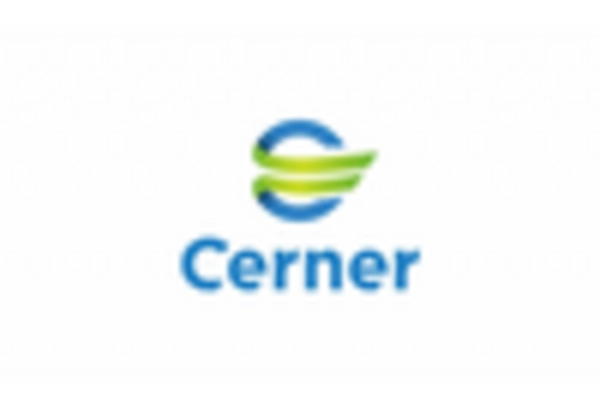Advancements in Technology
Technological advancements play a crucial role in shaping the Healthcare Electronic Data Interchange Market (EDI) Market. The emergence of cloud computing, artificial intelligence, and machine learning has revolutionized the way healthcare data is processed and exchanged. These technologies enable healthcare organizations to implement more sophisticated EDI solutions that enhance data accuracy and security. For instance, the adoption of cloud-based EDI systems allows for real-time data sharing among stakeholders, which is essential for coordinated patient care. Furthermore, the integration of AI-driven analytics can provide insights into patient trends and operational efficiencies. As a result, the continuous evolution of technology is likely to propel the growth of the Healthcare Electronic Data Interchange Market (EDI) Market, with organizations increasingly investing in innovative solutions to stay competitive.
Increase in Healthcare Expenditure
The increase in healthcare expenditure is a fundamental driver of the Healthcare Electronic Data Interchange Market (EDI) Market. As countries allocate more resources to healthcare, there is a corresponding need for efficient data management solutions to handle the growing volume of patient information. Higher healthcare spending often correlates with the adoption of advanced technologies, including EDI systems, which streamline administrative processes and improve data accuracy. According to recent reports, healthcare expenditure is expected to rise significantly in the coming years, prompting organizations to seek cost-effective solutions that enhance operational efficiency. This trend indicates that as healthcare expenditure continues to grow, the demand for EDI solutions will likely increase, further driving the Healthcare Electronic Data Interchange Market (EDI) Market.
Regulatory Compliance and Standards
Regulatory compliance is a pivotal driver in the Healthcare Electronic Data Interchange Market (EDI) Market. Governments and regulatory bodies worldwide are establishing stringent guidelines to ensure the secure exchange of healthcare data. Compliance with standards such as HIPAA in the United States mandates that healthcare organizations adopt EDI solutions to protect patient information. This regulatory landscape compels healthcare providers to invest in EDI systems that not only meet compliance requirements but also enhance data security and interoperability. The increasing focus on data privacy and security is expected to drive the adoption of EDI solutions, as organizations strive to avoid penalties and maintain trust with patients. Consequently, the emphasis on regulatory compliance is a significant factor influencing the growth trajectory of the Healthcare Electronic Data Interchange Market (EDI) Market.
Growing Focus on Patient-Centric Care
The shift towards patient-centric care is significantly influencing the Healthcare Electronic Data Interchange Market (EDI) Market. Healthcare providers are increasingly recognizing the importance of delivering personalized care experiences, which necessitates the efficient exchange of patient data. EDI systems facilitate the timely sharing of critical information among healthcare professionals, enabling them to make informed decisions that enhance patient outcomes. As healthcare organizations prioritize patient engagement and satisfaction, the demand for EDI solutions that support these objectives is likely to rise. Moreover, studies indicate that organizations that effectively utilize EDI systems report improved patient satisfaction scores and operational efficiencies. Therefore, the growing focus on patient-centric care is a vital driver propelling the Healthcare Electronic Data Interchange Market (EDI) Market.
Rising Demand for Efficient Data Management
The Healthcare Electronic Data Interchange Market (EDI) Market is experiencing a notable surge in demand for efficient data management solutions. As healthcare organizations increasingly seek to streamline operations, the need for effective data exchange mechanisms becomes paramount. The integration of EDI systems facilitates the seamless transfer of patient information, billing data, and clinical records, thereby enhancing operational efficiency. According to recent estimates, the EDI market is projected to grow at a compound annual growth rate (CAGR) of approximately 10% over the next few years. This growth is driven by the necessity for healthcare providers to reduce administrative costs and improve patient care through timely access to accurate data. Consequently, the rising demand for efficient data management is a significant driver in the Healthcare Electronic Data Interchange Market (EDI) Market.


















Leave a Comment